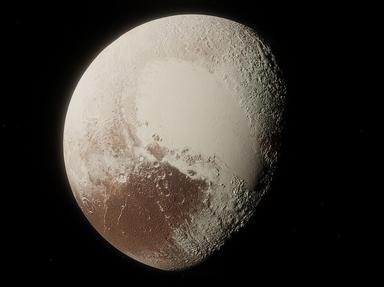Quiz Answer Key and Fun Facts
1. For decades after its discovery, little was known about Pluto and we had no clear images of what it looked like. This changed dramatically in 2015, when which space probe became the first spacecraft to explore this mysterious world?
2. Pluto famously lost its status as the ninth planet of the solar system in 2006 when it was redesignated as a dwarf planet by the International Astronomical Union. One of the factors influencing this decision was that the dwarf planet Eris (pictured) was found to be larger than Pluto.
3. A striking geological feature of Pluto is the large light-coloured region in the northern hemisphere nicknamed the Heart because of its double-lobe shape. What is it more formally known as?
4. What is the main component of Pluto's atmosphere?
5. Charon is Pluto's largest moon by far, being about half the size of the latter and about 12% as massive. Because of Charon's relatively large size compared to Pluto, they are mutually gravitationally locked, always keeping the same face towards each other.
6. The north polar region of Charon has a very large dark red area that has what name inspired by a fictional place that "one does not simply walk into"?
7. Hydra, Pluto's' second largest moon, has what distinction?
8. The rotation of Nix, Pluto's third largest moon, has what unusual characteristic?
9. Kerberos, Pluto's fourth moon, has what unusual orbital feature?
10. Pluto's' fifth moon was originally known informally as P5 when it was discovered in 2012. In 2013, it was officially named after which of the following rivers that flowed through the mythical Hades?
Source: Author
agentofchaos
This quiz was reviewed by FunTrivia editor
rossian before going online.
Any errors found in FunTrivia content are routinely corrected through our feedback system.
